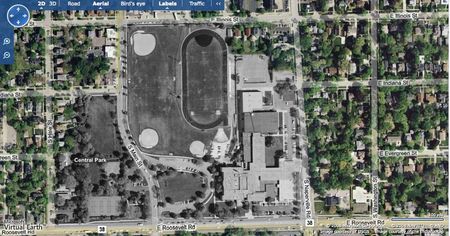Wheaton, Illinois
Wheaton Studio Fall 2008

(This studio project and its publication are supported by Champion Enterprises, Inc.’s gift to the Center for Building Communities.)
Wheaton (population 55,000) is a prosperous old railroad suburb of Chicago, the seat of DuPage County, and the home of Wheaton College. After decades of expansion, it is almost entirely built up and has no more cornfields to annex. Growth and development will now have to come from within. Hubble Middle School is being replaced by a new facility in another neighborhood. How its site is redeveloped will begin a new chapter in Wheaton’s history.
Named for the brilliant astronomer and Wheaton High School graduate Edwin Hubble (1889-1953), the school is located on 22 acres just north of Roosevelt Road, south of Wheaton’s downtown, and within four blocks of the commuter train station. Adjacent on the west is a 5-acre parcel of additional green space owned by the park district, and on the north, the vacant building and parking lot of a former supermarket. The current school’s core was built in 1925; multiple additions and renovations since have left little of historic interest except the facade.
The city and school district welcomed a Center for Building Communities studio of 10 fifth-year Notre Dame architecture students to propose ways to redevelop the site. Local officials and community members already have many ideas: upscale retail, housing that local teachers and police can afford, a connection between north and south Wheaton, hotel and conference space, a gateway to downtown, office and retail space, public space for arts presentations, a community amphitheater, and preservation of the existing green areas for middle-school football.
Just as the Hubble building suffers for past environmental sins (asbestos), so the site is constrained by the fact that central Wheaton was built on top of a creek. To prevent development from making floods more frequent and deeper, every cubic foot of fill added below the floodplain must be mitigated by adding 1 1/2 cubic feet of flood storage nearby — limiting what can be done on much of the site, and adding to the design challenge.
